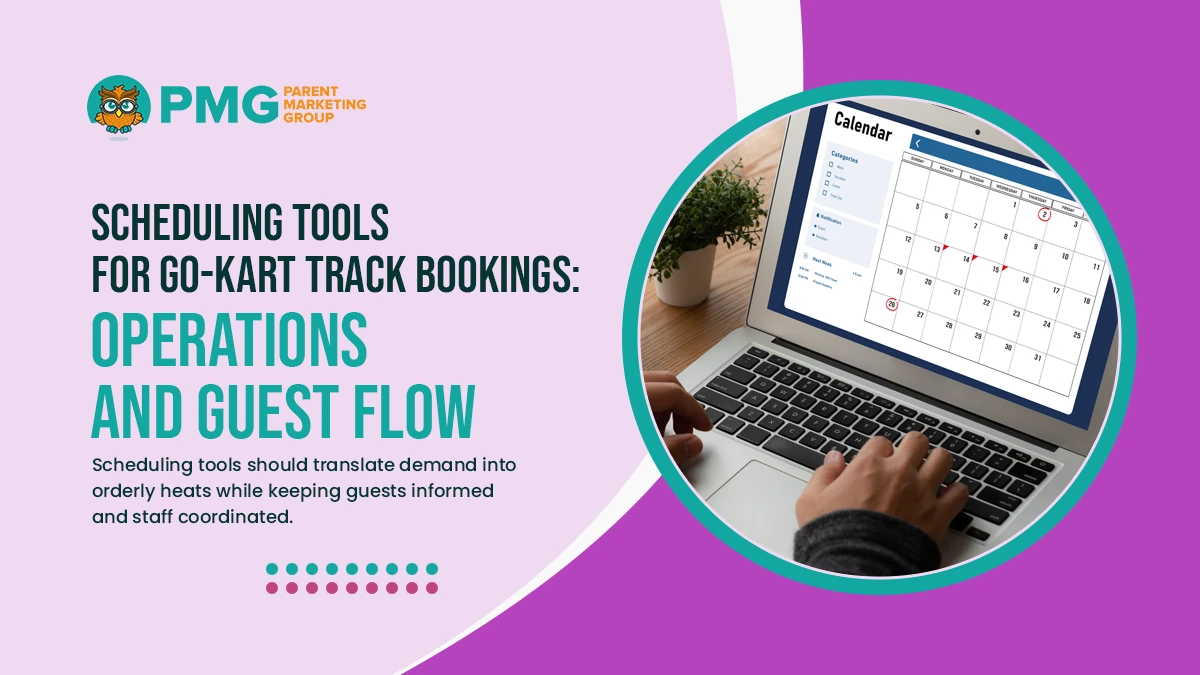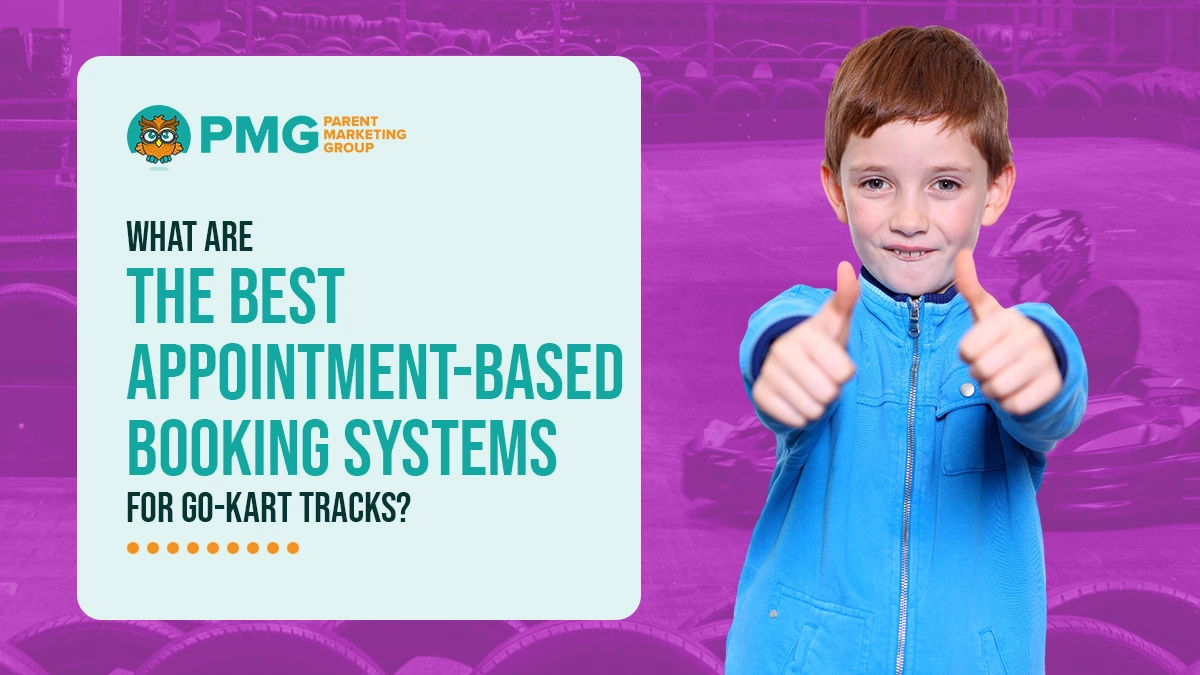Appointment booking software for go-kart tracks organizes demand into predictable heats, reduces wait times, and protects revenue through paid reservations and deposits. The right platform coordinates multi-lane capacity, age, height rules, and waiver collection while streamlining online, phone, and walk-in bookings into a single schedule.
Key evaluation capabilities include dynamic time-slot management, group and party workflows, rental inventory tracking, and secure payments with refunds or rescheduling controls. Look for SMS and email reminders, digital waivers tied to each racer, and clear reporting on utilization, no-shows, and average order value. Strong POS and CRM integrations ensure every reservation translates into a faster check-in and a better guest experience.
Online Reservation Systems for Karting Venues: Core Selection Criteria

Choosing the right platform begins with how well it fits your track layout, staffing model, and guest expectations. Prioritize systems that convert demand into predictable heats while protecting safety, revenue, and guest experience.
Capacity Models and Heat Structures
Your booking engine must mirror real operations, not force operations to fit software. Map how many karts, lanes, and simultaneous heats you can support at peak.
- Heat Configuration: Define duration, grid size, and turnaround so every slot reflects actual throughput.
- Multi-Track Coordination: Balance starts across tracks to avoid queue spikes and idle stretches.
- Private/Buyout Logic: Reserve full heats or tracks for groups without blocking unrelated inventory.
After modeling capacity, confirm the calendar enforces limits automatically and surfaces conflicts before guests pay.
Time-Slot Logic and Turnover
Slot logic determines whether check-ins stay smooth on busy days. Look for tools that absorb minor delays without cascading into long waits.
- Buffers and Prep Windows: Insert cleanup, briefing, and helmet-fit time between heats to protect schedules.
- Staggered Starts: Offset parallel heats to flatten arrival waves and reduce bottlenecks at gear-up.
- Blackouts and Maintenance Holds: Remove inventory instantly for incidents, kart service, or weather.
Test with simulated peak traffic to verify the system maintains on-time starts and displays accurate ETAs.
Eligibility Rules and Automated Checks
Safety and compliance need to be built into the reservation flow. The system should prevent ineligible bookings upfront and collect the required documents.
- Age/Height Validation: Enforce requirements by kart class with clear guidance for guardians.
- Digital Waivers: Tie signed waivers to each racer profile and heat for faster check-in.
- Equipment Assignment: Track helmet sizes and double-seater availability to avoid day-of shortages.
Ensure staff screens show flags for exceptions and that reports archive consent records for audits.
Payments, Deposits, and Rescheduling Controls
Revenue protection is essential when demand is spiky. Choose platforms that reduce no-shows and keep lanes full without manual work.
- Configurable Deposits: Capture partial or complete payment with clear cutoff times and fees.
- Self-Serve Changes: Allow guests to reschedule within policy to preserve utilization.
- Refunds, Credits, and Gift Cards: Standardize outcomes so staff decisions stay consistent.
Review settlement speed, dispute handling, and reporting so finance can reconcile daily and marketing can measure average order value and no-show rate.
Scheduling Tools for Go-Kart Track Bookings: Operations and Guest Flow

Scheduling tools should translate demand into orderly heats while keeping guests informed and staff coordinated. The focus is on predictable timing, smooth check-in, and accurate assignments that reflect real capacity.
Check-In, Kiosk, and Queue Management
Efficient arrival sets the tone for the visit. Look for tools that minimize lines and reduce manual entry.
- Self-Service Kiosks: Enable waiver signing, payment, and check-in to shorten counterside tasks.
- QR/Barcode Scanning: Tie each racer to a booking and heat for rapid gear pickup and staging.
- Queue Transparency: Display ETA boards and send SMS updates so families know when to suit up.
- Exception Handling: Manage late arrivals and gear-fit changes without disrupting the next heat.
Clear instructions and visible timers help guests pace their prep and reduce repeated questions.
Heat Assignment and Lane Balancing
Automated assignment protects throughput and fairness. The system should reflect kart classes, double-seaters, and safety rules.
- Auto-Seeding: Place racers into the correct heat based on booking details and eligibility.
- Lane Balancing: Distribute starts across lanes to prevent spikes at staging or marshal posts.
- Turnaround Protections: Enforce buffers for briefing, helmet fit, and kart checks between heats.
- Contingency Swaps: Reassign seats instantly when a kart is pulled for maintenance.
A live timeline lets supervisors spot bottlenecks early and keep starts on time.
Group and Party Scheduling
Groups require linked resources and clear handoffs between activities. The tool should prevent conflicts and protect room times.
- Linked Resources: Reserve party rooms, cake windows, and track time in one workflow.
- Deposit and Headcount Rules: Lock inventory while allowing controlled changes before cutoff.
- Add-On Management: Track bundles such as gloves, medals, or photo packs for accurate prep.
Integrated reminders with arrival instructions reduce overruns and improve guest satisfaction.
Staff Views, Role Permissions, and Alerts
Operational clarity improves safety and service. Provide each role with only what they need to act quickly.
- Role-Based Dashboards: Distinct views for front desk, staging, marshals, and managers.
- Real-Time Timeline: One schedule for all heats with flags for delays and incidents.
- Alerting and Escalations: Notify teams about late groups, weather holds, or equipment issues.
Audit trails support coaching and maintain consistent decisions during busy periods.
Peak-Day Protocols and Recovery
High volume demands structured recovery paths that protect the guest experience.
- Overflow Heats: Add controlled extras without breaking buffers or safety checks.
- Rescue Holds: Keep a small inventory in reserve to absorb slips in the schedule.
- Make-Good Options: Offer credits or rebooking windows that preserve goodwill and utilization.
Post-day reports should highlight dwell time at each station so the team can tune staffing and buffers before the next rush.
Integrated Booking System for Family Entertainment: POS and CRM Stack

An integrated stack connects bookings, payments, and guest data so every reservation becomes a faster check-in and a measurable sale. The goal is a single source of truth that supports on-site operations, targeted messaging, and transparent revenue reporting.
POS Integration and Unified Cart
Your booking platform and POS should function as one system of record for items, taxes, and tenders. This prevents double entry and improves counter speed.
- Itemized Modifiers: Sync helmets, gloves, photos, and party add-ons so bundles price correctly online and in person.
- Tender and Settlement: Map deposits, gift cards, and partial payments to POS tenders for accurate close-of-day totals.
- Receipt and Redemption: Issue QR codes or barcodes so staff can scan redemptions and reduce manual lookups.
Two-way inventory and pricing updates keep offers consistent across web, kiosk, and counter.
CRM Journeys and Audience Management
A connected CRM turns guest activity into timely, relevant communication tied to outcomes. Keep journeys simple, compliant, and measurable.
- Lifecycle Sequences: Automate inquiry-to-deposit, birthday follow-ups, and post-visit win-backs with clear goals.
- Segmentation Rules: Build audiences by age bands, household, membership status, and last visit date.
- Messaging Channels: Coordinate email and SMS with opt-in capture and preference management.
UTM tracking and campaign IDs written to profiles allow attribution back to specific messages and offers.
Data Synchronization, Identity, and Waivers
Data quality supports operations and safety. Use deterministic keys to connect records while respecting privacy choices.
- Identity Resolution: Link booking IDs, guest profiles, and devices to prevent duplicates and improve match rates.
- Consent and Privacy: Capture marketing consent, honor opt-outs, and restrict underage data per policy.
- Waiver Linkage: Attach signed waivers to each participant and heat for faster staging and audits.
Role-based access ensures front-line staff see only operational details, while managers view complete histories.
Analytics, Attribution, and Value Transfer
Reporting should elevate decisions, not just count visits. Focus on revenue events and lift, then feed results back to media.
- Revenue Events: Track deposits, walk-ins, add-ons, and party totals as first-class conversion values.
- Cohort KPIs: Monitor utilization, no-show rate, average order value, and lifetime value by segment.
- Value Uploads: Send offline conversions to ad platforms for value-based bidding and smarter spend.
Scheduled QA on IDs, timestamps, and tax totals keeps dashboards trustworthy and supports weekly optimization.
Implementation Timeline and Change Management
A structured rollout reduces disruption and builds confidence across teams. Use clear milestones, owned tasks, and short feedback loops so the system stabilizes quickly and supports reliable throughput.
Discovery and Configuration (Weeks 0–2)
Begin by aligning software settings with real operational constraints and goals. Document tracks, karts, heat length, and resource limits.
- Requirements Baseline: Capture capacity, eligibility rules, deposits, and refund policies.
- Configuration Map: Define calendars, time-slot buffers, and party workflows.
- Data Owners: Assign leads for items, pricing, taxes, and waivers.
- Risk Register: List dependencies such as payment gateways and kiosk hardware.
Hold a sign-off session so teams agree on the scope before any migration or training starts.
Data Migration and Sandbox Testing (Weeks 2–3)
Load essential records into a sandbox and validate each flow end-to-end. Simulate peak days before touching production data.
- Data Loads: Import items, pricing, user roles, and legacy bookings.
- Test Cases: Run sample heats, waivers, deposits, and reschedules.
- Reconciliation: Check taxes, tenders, and settlement reports.
- Defect Triage: Prioritize fixes with clear owners and deadlines.
Repeat only until the critical path is stable: bookings created, paid, redeemed, and reported correctly.
Staff Training and Standard Operating Procedures (Weeks 3–4)
Train every role on the specific screens and actions they use. Reinforce with concise SOPs and quick-reference guides.
- Role Playbooks: Front desk, staging, marshals, and managers.
- Exception Scenarios: Late arrivals, gear fit changes, and refunds.
- Security and Privacy: Permissions, consent, and waiver access.
- Job Aids: Checklists for opening, mid-day resets, and closing.
Collect questions daily and update SOPs so guidance reflects real situations.
Pilot Heats and Go-Live Checklist (Weeks 4–5)
Run a limited pilot during controlled hours to validate timing and handoffs. After the checklists pass, move to full hours.
- Go-Live Checks: Payments, scanners, kiosks, printers, and signage.
- Operational Buffers: Extra staff and spare equipment on site.
- Communication Plan: Guest emails, SMS, and on-site notices.
- Contingencies: Manual fallback for booking, refunds, and waivers.
Debrief after each pilot day and adjust buffers or staffing as needed.
30/60/90-Day Optimization and Governance
Use a set cadence to protect standards and improve results. Review data, decisions, and defects in one forum.
- Weekly KPIs: Utilization, no-show rate, average order value, and disputes.
- Change Requests: Intake, impact review, and version control.
- Vendor Touchpoints: Support tickets, roadmap items, and SLAs.
- Training Refresh: New hires and updates to SOPs and job aids.
Publish a brief monthly summary so leadership sees progress and remaining risks.
Conclusion
A reliable booking platform should feel invisible to guests and indispensable to your team. When reservations, waivers, payments, and resources move in one rhythm, check-in is faster, heats start on time, and staff can focus on safety and service. The right system turns busy days into a steady flow, protects revenue with clear policies, and gives managers clean data to guide staffing and pricing.
Need help selecting and implementing appointment booking software for go-kart tracks? Call (716) 303-4133 or visit https://parentmarketing.com/contact-us.






